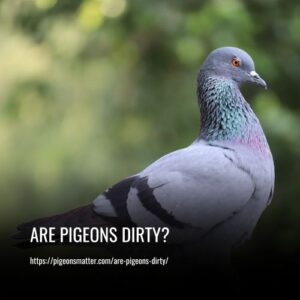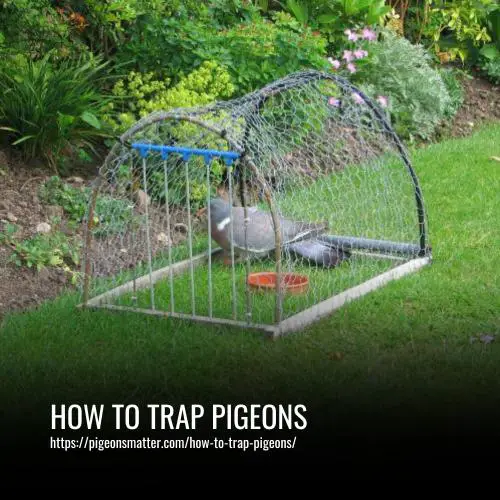If your cat is making pigeon-like vocalizations, it’s important to consider whether this is normal behavior for them or something new. Cooing and chirruping are typically normal vocalizations for cats and often indicate happiness, curiosity, or friendliness.
If your cat frequently makes these sounds during their usual activities, it’s a sign that they are happy and enjoying life. You don’t need to worry about these cooing noises and can rest assured that your cat is feeling playful and engaged.
Cats can sound like pigeons for many reasons. Among them are the significant reasons:
- To Get You to Follow.
- Communication.
- Bonding.
- For Attention.
- Attention-seeking.
- To Spark Conversation.
- As a Greeting.
- Changes In Vocalisation.
- Other Vocalisations.

Reasons Your Cat Sounds Like a Pigeon
Trilling is a positive sound that cats make when they’re happy, excited, or calm. Here are some possible explanations for this behavior:
1. To Get You to Follow:
While adult cats may not vocalize with each other, they do communicate in other ways. Mother cats use a unique pigeon sound to communicate with their kittens, signaling them to follow her.
If your cat trills you, it’s a sign of excitement and a desire for your attention. Your cat may lead you to something they need, such as a refill of their water bowl, a clean litter box, or their favorite toy. It’s important to pay attention to your cat’s vocalizations and behaviors to ensure their needs are met and they are happy and healthy.
2. Communication:
Trilling is a common way for cats to communicate with their owners or other cats. It’s a friendly greeting or a way of expressing excitement about something. When a cat trills, it produces a high-pitched, chirping sound that is different from a meow or a purr. Trilling is often accompanied by another body language, such as a tail twitch or a head nod.
Cats may trill when they see their owners or other cats, when they are excited about playtime or food, or when they want attention. If your cat trills you, it’s a sign that they are happy and content in your presence.
3. Bonding:
Trilling is a behavior that cats exhibit to form a bond with their owners, indicating their trust and comfort in their presence.
4. For Attention:
Contrary to popular belief, cats are not always self-sufficient and can be quite attention-seeking. Trilling is one way in which cats try to get their owner’s attention.
Attention-seeking cats may make these pigeon-like noises as they rub against your legs or stare at you from across the room. These trills often transition into purring as soon as they receive the desired attention.
It’s important to give your cat the attention they crave to ensure they feel loved and happy.
5. Attention-seeking:
When cats trill and rub against their owner’s legs, it could be a sign that they want attention or affection.
6. To Spark Conversation:
Cats can be quite chatty, and sometimes they just want to have a conversation with their favorite human.
If your cat meows, trills, or chirps at you, it’s likely that they’re feeling a little lonely and looking for attention. Try responding with a high-pitched meow or trill, and your cat may respond in kind.
It’s interesting to note that while you may both be communicating in your language, neither of you truly understands what the other is saying. But that’s okay – the important thing is that you’re bonding and spending time together.
7. As a Greeting:
Cats may not communicate with humans through vocalizations as effectively as dogs, but they have their unique ways of expressing themselves. One of the most common ways cats greet their owners is through trilling.
Trilling is often a sign of a warm welcome, especially when paired with bunting or snuggling. If your cat trills you when you come home from work or have guests over for dinner, it’s likely a friendly greeting.
However, trilling is just one of the many sounds cats use to communicate. Understanding basic cat noises can help you better understand your furry friend’s moods and needs. Check out the Jackson Galaxy video below for more information on decoding your cat’s vocalizations.
8. Changes In Vocalisation:
If your cat is making unusual sounds, it’s important to pay attention to the duration and frequency of the behavior. If this is a new development, it could be a sign of an infection or allergy. It’s recommended to consult with a veterinarian if the behavior persists for more than a day or two.
Minor infections can often resolve themselves, but it’s important to monitor your cat’s symptoms and behavior. If your cat seems feverish, is not eating, or is having trouble using the litter box, it could indicate a more serious infection.
Additionally, it’s important to check your cat’s face, head, and throat for any injuries or abnormalities. Any signs of blood, swelling, or abrasions should be treated with caution, as they could be causing the change in vocalizations. Overall, it’s important to be attentive to your cat’s health and behavior to ensure its well-being.
9. Other Vocalisations:
Cats are known for their wide range of vocalizations, each with their unique meaning. Loud cries can indicate distress or irritation while hissing and growling are clear warning signs that the cat is angry and should be left alone. A prolonged yowl is common among some cats, especially females in heat.
Some cats make an unusual chattering sound when they see birds, which is an instinctive attempt to mimic bird calls and lure them closer. This can be startling if you’re not used to it. Cats can also make speech-like sounds in rare cases, with some cats learning to produce one or two words.
These talking cats usually mimic their owners, with one cat learning to approximate their owner’s name and another learning to say “milk” by the fridge. It’s important to remember that cats have their unique ways of communicating and understanding their vocalizations can help you better understand their needs and behaviors.
How Cats Communicate
Contrary to popular belief, cats are not bad at communication. They use four different means to communicate: visual, tactile, olfactory, and auditory. Visual communication includes body posture and eye contact, while tactile communication includes rubbing up against others and grooming. Olfactory communication involves fecal or urine marking, and auditory communication includes all cat vocalizations, such as purring and hissing.
Cats have a wide range of vocalizations, with 21 distinct ones described in a 2019 review of the available literature. It’s been suggested that their vocal repertoire is more developed and complex than that of any other carnivore. So, next time your cat seems a bit smug, remember that they have earned the right to act that way. And, if only they could text us back, they probably would.
What Is A Trill?
If you’ve ever heard your cat making a cooing sound, it’s likely a trill. This sound is characterized by a rolling “r” with a rising intonation, almost as if the cat is asking a question. According to Dr. Georgina Ushi Phillips, DVM at Better With Cats, the trill is a common way for cats to communicate with their owners.
It’s a friendly and inquisitive sound that shows your cat is happy and comfortable around you. So the next time your cat trills at you, feel free to trill back and start a conversation!
Do All Cats Trill?
Trilling is a unique vocalization that some cats make, and it can vary in volume and frequency. According to Wieber, all cats with normal larynx function can trill, but some cats trill more than others. For example, her cat Moscow is the king of trilling and trills when he enters a room, solicits petting, greets other cats, and plays with toys. Moscow’s trilling is an expression of his jovial nature and social personality.
If you haven’t heard your cat trill before, there’s no need to worry. However, Wieber advises that you listen for it next time you greet, feed, or play with your cat. You may have just not noticed it before.
It’s A Sign Your Cat Is Happy
Cats use trilling and cooing sounds to communicate their happiness and greet their owners or other cats. This sound is often used by mother cats to get the attention of their kittens and is a sign of a content and happy cat. Trills and chirrups are considered friendly greetings and are a sweet way for cats to say hello.
Although cats may not smile like humans, they have other ways of expressing their happiness, such as frequently meowing or trilling at their owners. If your cat is exhibiting these behaviors, it’s a sign that they are content and comfortable in their environment.
It’s Part Of Your Cat’s ‘Vocabulary’
Cats are capable of making a wide range of vocalizations, and each cat has its own unique voice. According to Dr. Delgado, scientists have identified at least 12 different vocalizations that cats can make. A cat’s trill can also be unique to them, with one cat’s trill sounding like a pigeon while another’s may sound like a squawk.
It is common for cats to have their distinctive trilling sound, just like they can have different-sounding meows. Some cats may have more emphatic trilling sounds than others, as noted by Dr. Phillips.
FAQs
Trilling is a chirping or cooing sound that cats make, which is distinct from meowing. This sound is often used by cats to communicate with their kittens or humans and is a way of saying “Hey, look at me.”
Trilling is a friendly and welcoming sound, and cats may use it to greet their owners or to ask for attention. It’s a sign that your cat is happy and content, and they want to engage with you. If your cat trills you, it’s a good idea to respond with affection and attention, as this will strengthen your bond with your furry friend.
Trilling is a common way for adult cats to express their love and pleasure. If your cat trills, it could be a sign that they want to be petted or are seeking your attention. Trilling is a sound that is often associated with contentment and happiness in cats.
It’s important to pay attention to your cat’s body language and vocalizations to understand its needs and emotions. Trilling can be a way for your pet to communicate their affection and bond with you, so it’s essential to respond with love and attention to strengthen your relationship.
Purring is a common behavior exhibited by cats when they are content. It’s often associated with relaxation and happiness. Cats will purr even when they are sleeping, indicating that they are comfortable and at ease. If your cat is purring, it’s a good sign that they are feeling content and happy.
However, it’s important to note that cats can also purr when they are in pain or anxious, so it’s essential to pay attention to other behaviors and signs of distress. Overall, purring is a positive and reassuring sign that your cat is feeling comfortable and relaxed in their environment.
Cats crying at night have been linked to bad luck in many cultures. This behavior is often seen as a sign of impending misfortune. According to some beliefs, a cat moaning in the middle of the night indicates that someone is about to pass away.
While there is no scientific evidence to support these beliefs, some people still take them seriously. If you hear a cat crying at night, it’s important to remember that it’s just natural behavior for felines. However, if you notice your cat crying excessively or showing other signs of distress, it may be worth consulting with a veterinarian to ensure that your cat is healthy and happy.
Conclusion:
If your cat sounds like a pigeon, don’t panic! It’s quite common and can be caused by a variety of reasons. From respiratory issues to vocalization habits, there are many possible explanations. The important thing is to observe your cat’s behavior and seek veterinary advice if necessary.
Remember, every cat is unique and has their quirks, including their meows and purrs. Embrace the pigeon-like sounds and enjoy the unique personality of your feline friend!


